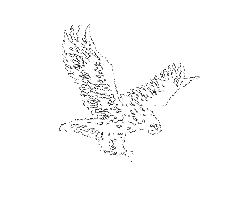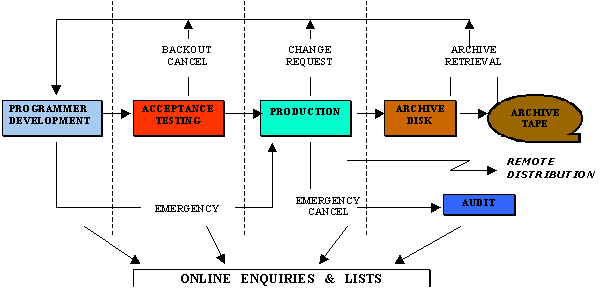
FENIX/400 - Change Management System
If you are currently responsible for an IBM AS/400 installation or network and require further control over the development and/or maintenance of your software environment through the full development cycle, you may want to consider FENIX/400 for the following reasons:
FENIX/400 Change Management - Object Flow
System Concepts
FENIX/400 is based on dividing and separating the system area into 4 distinct areas and then providing an interface between these areas managed by a secured menu driven system to establish full control in the movement of objects across them, namely:
FENIX/400 also logically separates the various functions required by Change Management as follows:
Project Control
Every modification applied to a system (environment) using FENIX is identified by a project number (PRN). Every project is divided into tasks, identified by task numbers (TSK). Each system can have up to 99999 project numbers and within each project up to 99999 tasks may be defined. Project and task numbers may be automatically defined by FENIX or user-defined.
The project/task logging procedures allows the user to define normal project/task parameters such as start/end dates, priority, internal document numbers,...etc., including an unlimited documentation option for full project/task description.
Programmers may request objects under a given project/task only if authorised to the project and task. This authority may be revoked at any time.
All forms required for object promotion through the various stages (development to acceptance to production) are automatically generated by FENIX.
Object Change Management and Version Control
The system automatically logs every stage in the life-cycle of an object with a date and time stamp, therefore, providing a means of measuring productivity, scheduling and/or identifiying program problem areas.
Version control is established as follows:
When new versions are moved to production,objects already in production are never deleted or replaced but moved to the archive area on disk and later to magnetic tape for permanent retention.
Emergency Modifications
FENIX automatically generates a range of predefined projects numbers for all emergency modifications. Emergency modifications once removed from production, are automatically moved to a holding area outside production where they are retained for scrutiny by audit.
Multi-System Multi-Installation
Due to the flexibility of FENIX, any number of systems (environments) and/or applications may be set up at the same installation and/or on the same machine. FENIX/400 also provides for distribution of object and/or source between FENIX installations via communication lines and/or magnetic media.
Archive Management and Retrieval
All objects archived, both online and offline are also managed by FENIX with options to retrieve from any archive location whether online (disk) or offline (magnetic tape).
Enquiries and Lists
FENIX/400 provides a full online enquiry and listing facility with selection options of all objects on the system and/or in the various archive locations. The selection options include the following:
Introduction
FENIX/400 may be installed and up and running within minutes. This is acheived as it may be setup to adapt to any existing library naming convention, is simple and easy to use, requires very little user training, and can be installed without interfering with ongoing work.
FENIX/400 does not intimidate development staff but actually simplifies their tasks while giving senior development staff the tools necessary to monitor and control day-to-day events.
FENIX/400 is designed to cope with all AS/400, S/36 and S/38 object types, including objects and/or sources from 4GL generators.
FENIX/400 simplifies the management and distribution of sources and/or objects to other AS/400s at local and/or remote sites while maintaining a complete log of all distribution. This feature also simplifies the distribution of pakaged software upgrades and maintenance toclient sites in a controlled manner.
Helps you keep track of what software is being modified by whom/by project/task/date and time/version/status...etc.
FENIX/400 automatically identifies all objects going into or out of production with date and time stamps. Objects going into production are automatically given their appropriate ownership and authorisation, therefore, eliminating the authority-related errors that so often cause production runs to crash.
Provides an interface for objects and/or sources from 4GL application generators such as SYNON and AS/SET.
The auditing options available assist the auditors in completing their tasks without disrupting ongoing development work. FENIX/400 makes full use of the AS/400 security features and has been recommended by international auditors.
FENIX/400 is currently available in English and Spanish.
FENIX/400 Concepts

A software environment controlled by FENIX/400 is called a system. A system will consist of one or more applications (or modules) which may or may not have anything in common.
All users of a given system (software environment) have to be identified to FENIX and then assigned relevant menu options to enable them to perform their tasks. This gives total flexibility in user/function set-up, which may vary between installations or between different systems at the same installation.